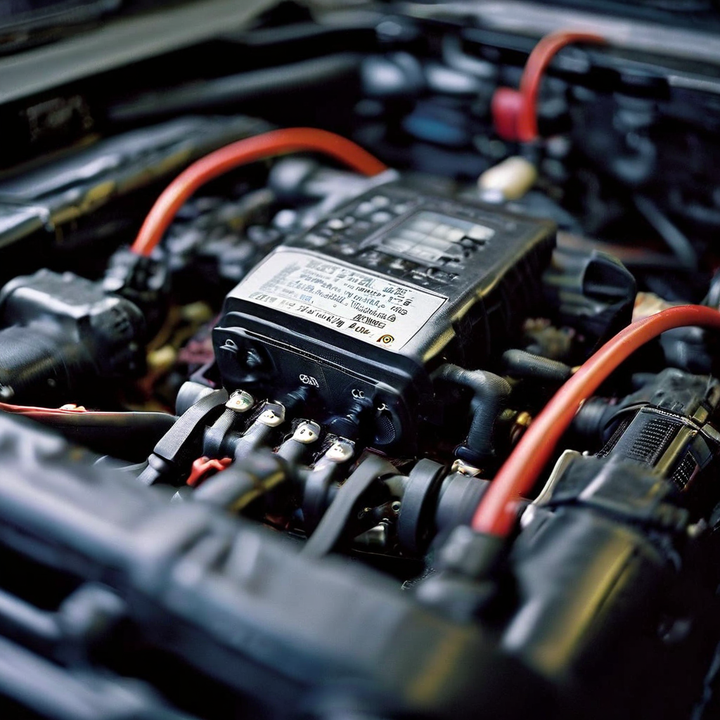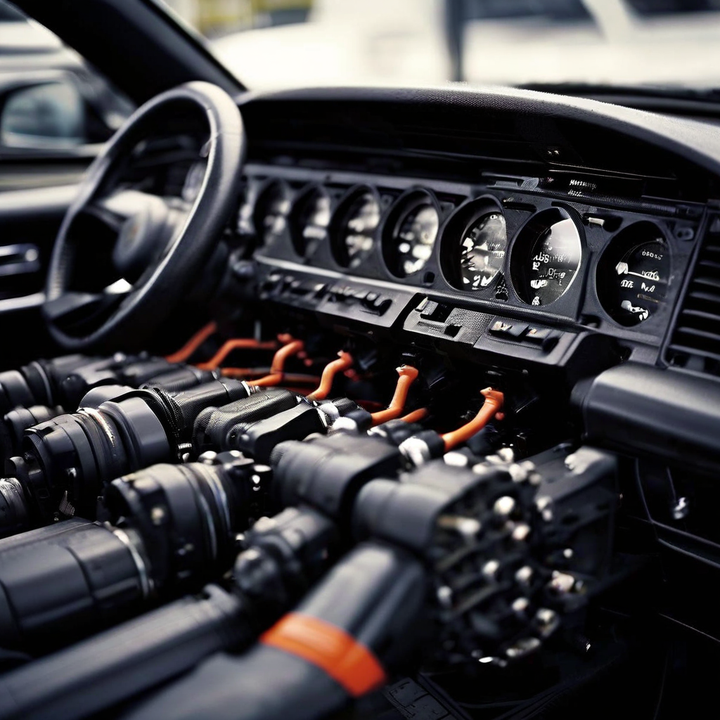


The diagnostic trouble code P03C5 indicates that the engine control module (ECM) has detected a high variation in the cylinder pressure for cylinder 5. This code is part of the OBD-II system and is considered a generic powertrain code, meaning it applies to all vehicle manufacturers.
Before we dive into the nitty-gritty details, let's first understand what this code signifies. The P03C5 code indicates that the engine's computer has detected an abnormal pressure variation in cylinder 5, which could be caused by a variety of factors. This code is often accompanied by symptoms such as:
| Symptom | Description |
|---|---|
| Rough idling | The engine may idle erratically or shake excessively |
| Decreased fuel efficiency | You may notice a drop in your vehicle's fuel economy |
| Engine misfires | The engine may misfire or run unevenly, especially under load |
Over the years, I've encountered several common causes that can trigger this code. Here's a breakdown of the most frequent offenders:
| Cause | Description |
|---|---|
| Faulty fuel injector | A malfunctioning fuel injector for cylinder 5 can cause improper fuel delivery, leading to pressure variations. |
| Leaking injector seal/o-rings | Worn or damaged seals and o-rings around the fuel injector can allow fuel leaks and pressure imbalances. |
| Intake valve issues | A stuck open, leaking, or otherwise faulty intake valve for cylinder 5 can disrupt the air/fuel mixture and pressure. |
| Exhaust valve issues | Problems with the exhaust valve for cylinder 5, such as leaks or sticking, can affect the cylinder's pressure. |
| Low compression | Worn piston rings, valve issues, or other internal engine problems can lead to low compression in cylinder 5, causing pressure variations. |
| Vacuum leaks | Leaks in the intake manifold gasket or other components near cylinder 5 can introduce unwanted air and affect pressure readings. |
| Faulty pressure sensor | In some cases, the cylinder 5 pressure sensor itself may be malfunctioning, providing inaccurate readings. |
As a mechanic, I follow a systematic approach to diagnose and resolve issues like the P03C5 code. Here are the steps I typically take:
Cylinder Leak Down Test
This test involves introducing compressed air into the cylinder and measuring the rate at which it leaks out.
It's an excellent way to identify compression issues and pinpoint the root cause, whether it's faulty valves, worn piston rings, or other internal engine problems.
Fuel Injector Inspection
I carefully inspect the fuel injector for cylinder 5, checking for any signs of leakage, damage, or electrical issues.
This often involves removing the injector and performing a visual inspection, as well as testing its operation with specialized equipment.
Vacuum Leak Check
Using specialized tools and techniques, I meticulously check for any vacuum leaks around the intake manifold gasket near cylinder 5.
Even the smallest leak can cause pressure variations and other performance issues.
Live Data Monitoring
With the help of a scan tool, I monitor the fuel trims and live data for cylinder 5 during idle and loaded conditions.
This provides valuable insights into the engine's behavior and can help pinpoint the source of the issue.
Sensor Swap
If all else fails, I may swap out the cylinder 5 pressure sensor with a known good one.
This helps isolate the issue and determine if the sensor itself is faulty or if the problem lies elsewhere.
Once the root cause has been identified, it's time to roll up my sleeves and get to work. Depending on the diagnosis, repairs may involve:
Replacing the faulty fuel injector for cylinder 5
Replacing the cylinder 5 pressure sensor
Replacing the intake manifold gasket to address vacuum leaks
Repairing or replacing faulty valves, valve seals, or piston rings to restore proper compression
Prevention is also key to avoiding future issues. I always emphasize the importance of following recommended service intervals for:
Fuel injector maintenance
Valve adjustments and replacements
Engine overhauls and rebuilds
Using high-quality fuel and keeping the fuel system clean can also go a long way in preventing problems. Additionally, I advise my clients to avoid severe driving conditions that could potentially damage engine components, such as:
Excessive idling
Frequent short trips (which prevent the engine from reaching optimal operating temperatures)
Aggressive driving or excessive engine load
Proper maintenance and responsible driving habits can significantly extend the lifespan of their vehicles.
When it comes to repairs, the costs can vary significantly depending on the root cause and the vehicle model. Here are some rough estimates to give you an idea:
| Repair | Estimated Cost Range |
|---|---|
| Fuel injector replacement | $200 - $500 for parts and labor |
| Cylinder pressure sensor replacement | $100 - $300 |
| Intake manifold gasket replacement | $200 - $500 |
| Valve, piston ring, or engine overhaul for low compression | $1,000 - $4,000+ |
It's important to note that these are just rough estimates, and the actual cost may vary based on factors such as:
Vehicle make and model
Labor rates in your area
Additional parts or services required
While these costs may seem daunting, it's important to remember that neglecting these issues can lead to further damage and even more expensive repairs down the line. That's why I always recommend having a professional mechanic diagnose and repair the issue promptly to avoid any unnecessary complications.
The P03C5 - Cylinder 5 Pressure Variation High code may seem like a complex issue, but with the right knowledge and approach, it can be resolved effectively. As a mechanic, I've seen my fair share of these codes, and I can assure you that with patience, attention to detail, and a systematic diagnostic process, we can get to the bottom of this issue and restore your vehicle's performance.
Remember, preventive maintenance is key to avoiding such problems in the future. By following recommended service intervals, using high-quality fuel, and driving responsibly, you can significantly reduce the likelihood of encountering diagnostic trouble codes like P03C5.
So, fellow automotive enthusiasts, fear not the P03C5 code! With the right guidance and a trusted mechanic by your side, you can tackle this issue head-on and keep your vehicle running smoothly for years to come.
The common symptoms of the P03C5 code include rough idling, decreased fuel efficiency, and engine misfires, especially under load.
The potential causes include a faulty fuel injector, leaking injector seals/o-rings, intake or exhaust valve issues, low compression, vacuum leaks, and a faulty cylinder 5 pressure sensor.
A cylinder leak down test involves introducing compressed air into the cylinder and measuring the rate at which it leaks out to identify compression issues.
Inspecting the fuel injector for cylinder 5 is crucial as a malfunctioning injector can cause improper fuel delivery and pressure variations.
Monitoring fuel trims and live data for cylinder 5 during idle and loaded conditions provides valuable insights into the engine's behavior and can help pinpoint the source of the issue.
A sensor swap, where the cylinder 5 pressure sensor is replaced with a known good one, is performed to isolate the issue and determine if the sensor itself is faulty.
Common repairs include replacing the faulty fuel injector, cylinder pressure sensor, intake manifold gasket, or repairing/replacing faulty valves, valve seals, or piston rings.
Following recommended service intervals for fuel injector, valve, and engine maintenance, using high-quality fuel, and avoiding severe driving conditions can help prevent future issues.
The estimated cost range for repairs can vary from $200-$500 for fuel injector or gasket replacement to $1,000-$4,000+ for valve, piston ring, or engine overhaul.
Having a professional mechanic diagnose and repair the issue promptly is important to avoid further damage and more expensive repairs down the line.

Miguel started tinkering with car radios as a teenager, fascinated by the intricate dance of wires and circuits. This passion led him to pursue a career as an automotive electrician. For the past 10 years, Miguel has tackled everything from flickering headlights to mysterious electrical gremlins. He thrives on troubleshooting electrical problems and enjoys sharing his knowledge to empower car owners to understand their vehicles better.



